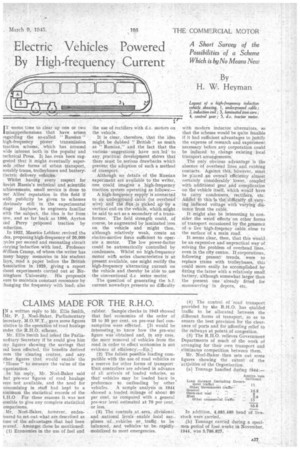Electric Vehicles Powered By High-frequency Current
Page 29

If you've noticed an error in this article please click here to report it so we can fix it.
A Short Survey of the Possibilities of a Scheme Which is by No Means New
By H. W. Heyman
I T seems time to clear up one or two misapprehensions that have arisen regarding the so-called " Russian " high-frequency power transmission traction scheme, which has aroused wide interest both in the popular and technical Press. It has even been suggested that it might eventually supersede ,other forms of urban transport, notably trams, trolleybuses and battery.tlectric delivery vehicles.
Whilst having every respect for soviet Russia's technical and scientific ichievements, small service is done to 3ur Allies' reputation in this field if wide publicity be given to schemes 3bviously still in the experimental 3tage Anyhow, to engineers familiar with the subject, the idea is far from new, and as far back as 1896, Ayrton mil Perry "proposed traction by nduction.
In 1922, Maurice Leblanc revived the _dm proposing high-frequency of 20,000 :ycles per second and resonating circuit varying induction with load. Professor William Cramp, of whom the writer has nany happy memories in his student lays, read a paper before the British /association in 1928, giving a report ibont experiments carried out at Birmingham University. His proposals vere to maintain constant resonance by ;hanging the frequency with load; also the use of rectifiers with d.c. motors on the vehicle.
It is clear, therefore, that the idea might be dubbed " British " as much as " Russian," and the fact that the various suggestions have not led to any, practical development shows that there must be serious drawbacks which prevent the adoption of such a method of transport.
Although no details of the Russian experiment are available to the writer. one could imagine a high-frequency traction system .operating as follows:—
A high frequency supply is connected to an underground cable (Or overhead wire) and the Jinx is picked up by a vertical coil on the Vehicle, which might be said to act as a secondary of a transformer. The field strength could, of course, be augmented by laminated iron. on the vehicle and might then, although relatively weak, create an electro-motive force sufficient to operate a motor. The low power-factor could be automatically controlled by condensers. Whilst no high-frequency motor witti series characteristics is at present available, one might rectify the high-frequency alternating current on the vehicle and thereby be able to use the conventional d.c series motor.
The question of generating the h.f. current nowadays presents no difficulty
with modern inductor alternators, so that the scheme would be quite feasible if it had sufficient advantages to juStify the expense of research and experiment necessary before any corporation could be indticed to change existing local transport arrangements. The only obvious advantage is the absence of overhead lines and rubbing contacts. Against this, however, must be placed _an overall efficiency almost certainly considerably lower, coupled with additional gear and complication on the vehicle itself, which would have to carry condensers, rectifiers, etc. Added to this "is the difficulty of varying induced voltage with varying distance from the cable.
It might also be interesting to consider the weird effects on other forms of transport occasioned by the presence ofa live high-freqency cable close to the surface of a main road.
It seems clear, then, that this would be an expensive and impractical way of solving the problem of overhead lines. even in the city centre. If corporations, following present trends, were to replace trams with trolleybuses, this could more easily be accomplished by fitting the latter with a relatively small battery, although somewhat larger than the present one already fitted for manceuvring in depots, etc.





















































